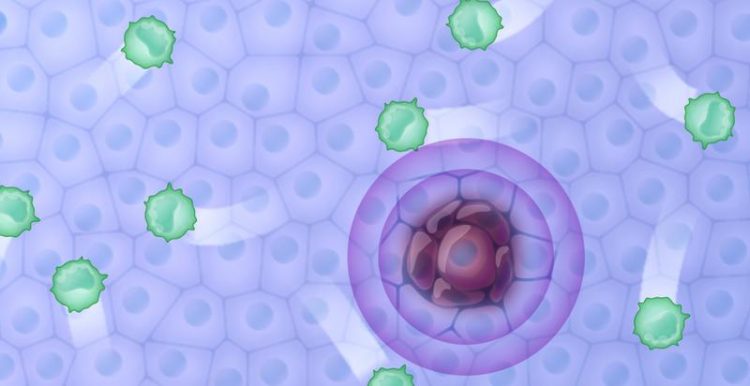How the Immune System Becomes Blind to Cancer Cells

Cancer cells become invisible to the body's immune response. Unhindered by T cells (green), they can continue to replicate. Scientists have now described an important step in this process called “immune escape”. Illustration: CIBSS/University of Freiburg, Michal Rössler
The team headed by Prof. Dr. Maja Banks-Köhn and Prof. Dr. Wolfgang Schamel from the excellence clusters for biological signaling studies CIBSS and BIOSS at the University of Freiburg and the structural biologist Prof. Dr. Teresa Carlomagno from the LUH used biophysical, biochemical, and immunological methods in their research.
Based on these insights, chemical biologist Banks-Köhn, hopes to develop drugs that intervene specifically in this activation mechanism. In the future, they could thereby improve established cancer treatments that rely on so-called immune checkpoint inhibitors. The team has recently published its research in a study in the scientific journal “Science Advances”.
Checkpoint inhibitors are therapeutic antibodies that work by binding to the receptors of T cells. Proteins on the surface of the T cells called immune checkpoint receptors such as programmed cell death 1, or PD1, along with the signaling pathways that are triggered by them are what stop immune responses in a healthy body.
This regulating mechanism prevents symptoms of inflammation from lasting too long and getting out of control. These symptoms include redness, swelling, and fever. Cancer cells take advantage of mechanisms such as these to render the body helpless while the cells multiply.
Using cell cultures and interaction studies, the researchers from the two universities discovered that a signaling protein called SHP2 in T cells binds to PD1 in two specific places after it has been activated by a signal from cancer cells. It is this double binding to SHP2 that promotes the camouflaging effect and switches off the immune cells’ response completely.
Antibodies that block immune inhibitors like PD1 are approved treatments for skin melanomas and lung carcinomas, and they prolong patients' lives. However, as a result, many patients suffer from autoimmune reactions.
“Drugs that prevent the binding of SHP2 and PD1 could be used in the future to make side-effects less severe and to support, or to act as alternatives to, antibody treatments,” says Banks-Köhn. She and Schamel studied the immune response of B cells and T cells by modifying SHP2 molecules, testing their predictions based crystal structure and magnetic resonance analysis of the team from the LUH.
Their data shows precisely how and in what areas the SHP2 protein binds to PD1, thereby revealing a possible target area for drugs. “In our ongoing research project at the CIBSS – Centre for Integrative Biological Signalling Studies the next step is to decode the signaling pathway of PD1 – in other words, where the proteins are located in the cell, where they bind, and within what time frame the signals take effect,” Banks-Köhn says.
Caption:
Cancer cells become invisible to the body's immune response. Unhindered by T cells (green), they can continue to replicate. Scientists have now described an important step in this process called “immune escape”. Illustration: CIBSS/University of Freiburg, Michal Rössler
Prof. Dr. Maja Banks-Köhn
Institute of Biology III / Excellence Clusters in Biological Signaling Studies CIBSS and BIOSS
Phone: +49 (0)761 / 203–67900
maja.koehn@bioss.uni-freiburg.de
Marasco, M./Berteotti, A./Weyershaeuser, J./Thorausch, N./Sikorska. J./Krausze, J./Brandt, H. J./Kirkpatrick, J./Rios, P./Schamel, W. W./Köhn, M./Carlomagno, T. (2020): Molecular mechanism of SHP2 activation by PD-1 stimulation. In: Science Advances 2020/6: eaay4458.
Media Contact
All latest news from the category: Life Sciences and Chemistry
Articles and reports from the Life Sciences and chemistry area deal with applied and basic research into modern biology, chemistry and human medicine.
Valuable information can be found on a range of life sciences fields including bacteriology, biochemistry, bionics, bioinformatics, biophysics, biotechnology, genetics, geobotany, human biology, marine biology, microbiology, molecular biology, cellular biology, zoology, bioinorganic chemistry, microchemistry and environmental chemistry.
Newest articles

High-energy-density aqueous battery based on halogen multi-electron transfer
Traditional non-aqueous lithium-ion batteries have a high energy density, but their safety is compromised due to the flammable organic electrolytes they utilize. Aqueous batteries use water as the solvent for…

First-ever combined heart pump and pig kidney transplant
…gives new hope to patient with terminal illness. Surgeons at NYU Langone Health performed the first-ever combined mechanical heart pump and gene-edited pig kidney transplant surgery in a 54-year-old woman…

Biophysics: Testing how well biomarkers work
LMU researchers have developed a method to determine how reliably target proteins can be labeled using super-resolution fluorescence microscopy. Modern microscopy techniques make it possible to examine the inner workings…





















